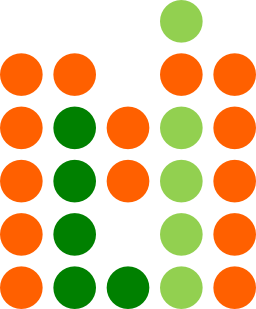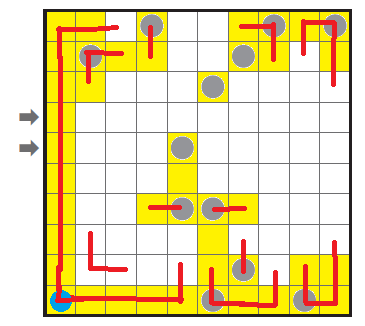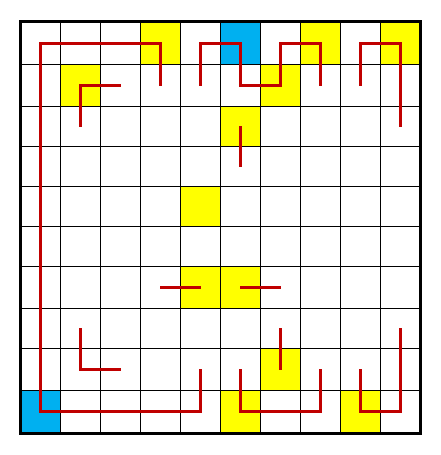 @ 2011-04-09 1:54 PM (#3965 - in reply to #3964) (#3965) Top
@ 2011-04-09 1:54 PM (#3965 - in reply to #3964) (#3965) Top
Posts: 1869








Country : India
debmohanty posted @ 2011-04-09 1:54 PM
that sounded funny.i didnt say the contestants would start calculating.in fact i liked this penalty(bonus)system:) Good and simple one.
To make it better,why not increase the number of intervals and make it 6 ,of 5 mins each.That can probably sharpen the evaluation.
Changing the interval to 5 minutes is an option. But it might become too stressful for players in last 30 minutes.
As the poll options indicate, we definitely can make adjustments to this system in future.
 @ 2011-04-09 2:17 PM (#3966 - in reply to #3965) (#3966) Top
@ 2011-04-09 2:17 PM (#3966 - in reply to #3965) (#3966) TopPosts: 774






Country : India
rakesh_rai posted @ 2011-04-09 2:17 PM
 @ 2011-04-09 2:36 PM (#3967 - in reply to #3910) (#3967) Top
@ 2011-04-09 2:36 PM (#3967 - in reply to #3910) (#3967) TopPosts: 140



Country : India
anurag posted @ 2011-04-09 2:36 PM
 @ 2011-04-09 5:25 PM (#3968 - in reply to #3910) (#3968) Top
@ 2011-04-09 5:25 PM (#3968 - in reply to #3910) (#3968) TopPosts: 140



Country : India
anurag posted @ 2011-04-09 5:25 PM
Edited by anurag 2011-04-09 5:30 PM
 @ 2011-04-09 6:10 PM (#3969 - in reply to #3968) (#3969) Top
@ 2011-04-09 6:10 PM (#3969 - in reply to #3968) (#3969) Top
Posts: 1869








Country : India
debmohanty posted @ 2011-04-09 6:10 PM
Odd skyscraper: Some evens inside look like valid skyscrapers .The 2,4 in the third row can be valid and satsify the outside '3' at the same time.Is that a problem with the example? or will that hold for the test puzzle too?
I think the rule and the example match perfectly.
 @ 2011-04-10 10:40 AM (#3970 - in reply to #3910) (#3970) Top
@ 2011-04-10 10:40 AM (#3970 - in reply to #3910) (#3970) TopPosts: 190





Country : New Zealand
kiwijam posted @ 2011-04-10 10:40 AM
As a middle-of-the-field solver, it doesn't change my strategy at all - I've always started with the puzzles that get me the fastest points, and leave the hard/slow ones for last. I assumed most people did this (unless they're intending to just do all the puzzles!).
If we scored this test normally, then wouldn't the rankings be almost exactly the same order anyway? e.g. we're all penalized a similar percentage of our total score in the end, except the fastest solvers who get an increased lead now.
 @ 2011-04-10 10:41 AM (#3971 - in reply to #3910) (#3971) Top
@ 2011-04-10 10:41 AM (#3971 - in reply to #3910) (#3971) TopPosts: 190





Country : New Zealand
kiwijam posted @ 2011-04-10 10:41 AM
 @ 2011-04-10 11:16 AM (#3972 - in reply to #3970) (#3972) Top
@ 2011-04-10 11:16 AM (#3972 - in reply to #3970) (#3972) Top
Country : United States
MellowMelon posted @ 2011-04-10 11:16 AM
 @ 2011-04-10 11:54 AM (#3973 - in reply to #3910) (#3973) Top
@ 2011-04-10 11:54 AM (#3973 - in reply to #3910) (#3973) TopPosts: 199





Country : United States
motris posted @ 2011-04-10 11:54 AM
One of the goals of the delayed scoring I think is to run shorter tests for longer times without necessarily compromising the results at the top. FLIP is a great example of this type of test. While this test has a lot of easy puzzles, it probably is still too long of a test to showcase the best benefits of this type of system, which would be a 40-60 minute for uvo test that gets run for 2 hours (or more) instead.
To build off Melon's comment, I'm not sure this system can ever better separate the virtual tie between Ulrich and myself when we are 1 second apart and completely correct, but diminished scoring can help when a solver stops solving (with something like an error) but is at 23/24 very early, versus 24/24 after much more time. The clearest example was unfortunate for me but on Broken Pieces where I was done first (several minutes ahead of others, 45 minutes before end of the test) but with an entry error that I never caught. I ended up 12th, but some (hopefully not just me) would say my rate of solving was fast enough that my small mistake equaling no time-bonus was not a big enough mistake to cost the amount of points it did. Broken Pieces was an easy test with about 2x the amount of time needed, and is maybe even a better test than FLIP to showcase where this scoring could improve rankings.
Edited by motris 2011-04-10 12:18 PM
 @ 2011-04-10 2:17 PM (#3974 - in reply to #3973) (#3974) Top
@ 2011-04-10 2:17 PM (#3974 - in reply to #3973) (#3974) TopPosts: 774






Country : India
rakesh_rai posted @ 2011-04-10 2:17 PM
...If we scored this test normally, then wouldn't the rankings be almost exactly the same order anyway? e.g. we're all penalized a similar percentage of our total score in the end, except the fastest solvers who get an increased lead now.
If the basic assumption for this system is that "top solvers should be able to finish the test within the first time slab (90 minutes, here)" then I do not understand how this system will help better define the rankings at the top (as they all are expected to finish within 90 minutes and rank according to their finish times anyway).
On the other hand, this system will further tend to increase the difference between top solvers and others. Top solvers will get (699 PLUS bonus) but others will be penalized and they may get about 70-90% of their score based on when and what they submitted. Compared to previous systems, there is no change in top solvers' score but others' scores is lesser. If this is what is desired, then, yes, this system indeed serves its purpose. But I am not sure that is what is desired.
Maybe, it can work better in easier tests.
 @ 2011-04-10 9:13 PM (#3975 - in reply to #3910) (#3975) Top
@ 2011-04-10 9:13 PM (#3975 - in reply to #3910) (#3975) TopPosts: 226



Country : Thailand
tamz29 posted @ 2011-04-10 9:13 PM
Once again I fell victim to the answer format - miscounted arrows, miscounted cells... not a good feeling.
Asides that, the new time format does raise some debates.
It's interesting, but I hate how prioritizing solving order suddenly becomes crucial.
What if this system is used on a test where the puzzles are all roughly the same level?
Then this would ultimately test solving speed as opposed to how well you plan your solving order.
 @ 2011-04-11 1:28 AM (#3978 - in reply to #3910) (#3978) Top
@ 2011-04-11 1:28 AM (#3978 - in reply to #3910) (#3978) TopPosts: 2
Country : United Kingdom
Janix posted @ 2011-04-11 1:28 AM
I am on holiday in Poland and have must managed to get a computer at 9:50pm on the Sunday evening, but I cannot find a start test on the TWIST page. Please can somebody put the password into this forum so that I can access the questions. I will email people in the UK my results at midnight. Thank you.
Ken
 @ 2011-04-11 2:03 AM (#3979 - in reply to #3978) (#3979) Top
@ 2011-04-11 2:03 AM (#3979 - in reply to #3978) (#3979) Top
Posts: 337




Country : Switzerland
Fred76 posted @ 2011-04-11 2:03 AM
Hi anyone
I am on holiday in Poland and have must managed to get a computer at 9:50pm on the Sunday evening, but I cannot find a start test on the TWIST page. Please can somebody put the password into this forum so that I can access the questions. I will email people in the UK my results at midnight. Thank you.
Ken
I think Deb is not here just now. I answer:
"I cannot find a start test on the TWIST page"
On the twist page, you must login before start. When you are logged, you'll see a big "start" button.
Fred
 @ 2011-04-11 2:14 AM (#3980 - in reply to #3978) (#3980) Top
@ 2011-04-11 2:14 AM (#3980 - in reply to #3978) (#3980) TopPosts: 103

Country : Serbia
Nikola posted @ 2011-04-11 2:14 AM
Regarding the previous discussion, I think it's time to stop experimenting with bonus systems and try to establish criteria that would apply to all future tests. For such single and one-time events, the first view, of course, should be the score, and then the solving time. I think it's very enough.
Nikola
 @ 2011-04-11 2:17 AM (#3981 - in reply to #3910) (#3981) Top
@ 2011-04-11 2:17 AM (#3981 - in reply to #3910) (#3981) TopPosts: 2
Country : United Kingdom
Janix posted @ 2011-04-11 2:17 AM
I am working on a very old laptop and I have just discovered a very small button half way down a blank page and I have started.
Thanks Fred
 @ 2011-04-11 5:24 AM (#3982 - in reply to #3970) (#3982) Top
@ 2011-04-11 5:24 AM (#3982 - in reply to #3970) (#3982) Top
Posts: 1869








Country : India
debmohanty posted @ 2011-04-11 5:24 AM
I don't understand why people like the reducing points. It's quirky and fun, but does it make the contest better?
As a middle-of-the-field solver, it doesn't change my strategy at all - I've always started with the puzzles that get me the fastest points, and leave the hard/slow ones for last. I assumed most people did this (unless they're intending to just do all the puzzles!).
If we scored this test normally, then wouldn't the rankings be almost exactly the same order anyway? e.g. we're all penalized a similar percentage of our total score in the end, except the fastest solvers who get an increased lead now.
Now that the contest is almost over, I can explain what was intended using some numbers.
I've always believed and encouraged that LMI contests should run longer than the time top solvers take to solve all puzzles. This make sure that top solvers solve all puzzles and other get more time solve puzzles.
In this test, I was thinking at least 2-3 players can solve 24 puzzles in 90 minutes, and may be few more players in 120 minutes, and some more players should solve 22 or 23 puzzles in 120 minutes. If I'm running a test 33% longer than what a top solver can finish in, we need to give enough time bonus for top solvers. But I decided to not give any time bonus, instead reduce the point value of puzzles.
Rohan, Palmer and Thomas were one of the first few guys to participate, and looking at their results, I thought the timing is correct.
But that was not to be, 90 minutes was ill-timed, and if the point-reduction-system was not successful, it is because of wrong chosen Test.
As few of you have noted, a FLIP or a Broken Pieces kind of test will show its true value.
Without summarily accepting or rejecting it, I think we can give it a try again when we can plan a proper Test.
 @ 2011-04-11 5:37 AM (#3983 - in reply to #3910) (#3983) Top
@ 2011-04-11 5:37 AM (#3983 - in reply to #3910) (#3983) Top
Posts: 1869








Country : India
debmohanty posted @ 2011-04-11 5:37 AM
Thomas solved all 24 puzzles in an incredible 86 minutes. Ulrich is the other one to solve all 24.
Among Indian results, Rohan is in top 10. That is an incredible performance IMO. Hope to see him get better.
Thank you everyone for participating.
 @ 2011-04-11 6:03 AM (#3984 - in reply to #3974) (#3984) Top
@ 2011-04-11 6:03 AM (#3984 - in reply to #3974) (#3984) Top
Posts: 1869








Country : India
debmohanty posted @ 2011-04-11 6:03 AM
On the other hand, this system will further tend to increase the difference between top solvers and others. Top solvers will get (699 PLUS bonus) but others will be penalized and they may get about 70-90% of their score based on when and what they submitted. Compared to previous systems, there is no change in top solvers' score but others' scores is lesser. If this is what is desired, then, yes, this system indeed serves its purpose. But I am not sure that is what is desired.
I'm not exactly sure if that is true.
If I ran this test for 120 minutes flat, motris would have got 869. This thing is one could argue for symbolic time bonus of 1 point per minute saved, but I always felt time bonus should be appropriately computed. Otherwise, it simply undervalues the exceptional performances by top solvers.
If the test was for 90 minutes, motris would lose 15 points to be at 719, but others would lose all the points they got for last 30 minutes.

Ok, agreed that the table above can't be exact since players' strategy could be different if the test ran for 120 minutes flat or for 90 minutes.
But I feel it provides very approximate information.
 @ 2011-04-11 6:32 AM (#3985 - in reply to #3910) (#3985) Top
@ 2011-04-11 6:32 AM (#3985 - in reply to #3910) (#3985) Top
Posts: 1869








Country : India
debmohanty posted @ 2011-04-11 6:32 AM
 @ 2011-04-11 6:38 AM (#3986 - in reply to #3984) (#3986) Top
@ 2011-04-11 6:38 AM (#3986 - in reply to #3984) (#3986) TopPosts: 9
Country : United Kingdom
ronald posted @ 2011-04-11 6:38 AM
I think it worked nicely here. (and, it helped, that the puzzles were all excellent)
Thanks :)
Ronald
 @ 2011-04-11 8:55 AM (#3987 - in reply to #3986) (#3987) Top
@ 2011-04-11 8:55 AM (#3987 - in reply to #3986) (#3987) TopPosts: 774






Country : India
rakesh_rai posted @ 2011-04-11 8:55 AM
Edited by rakesh_rai 2011-04-11 8:55 AM
 @ 2011-04-11 9:03 AM (#3988 - in reply to #3987) (#3988) Top
@ 2011-04-11 9:03 AM (#3988 - in reply to #3987) (#3988) Top
Posts: 1869








Country : India
debmohanty posted @ 2011-04-11 9:03 AM
I would be interested in the approach for missing breakpoints (the bigger one) ... if someone can point a couple of starting steps, that'd be great.
You can identify two missing circles (one in Column 1 and one in Row 1) without drawing a single line.
Did you get there?
 @ 2011-04-11 9:17 AM (#3989 - in reply to #3988) (#3989) Top
@ 2011-04-11 9:17 AM (#3989 - in reply to #3988) (#3989) TopPosts: 774






Country : India
rakesh_rai posted @ 2011-04-11 9:17 AM

 @ 2011-04-11 9:54 AM (#3990 - in reply to #3989) (#3990) Top
@ 2011-04-11 9:54 AM (#3990 - in reply to #3989) (#3990) Top
Posts: 1869








Country : India
debmohanty posted @ 2011-04-11 9:54 AM
I am very poor at such puzzles....I could get one missing circle for column 1, hopefully its correct...for row 1, still not sure. Here's where I have got to, so far. (I don't want to look at the solution before solving it completely)
The thing with Missing Breakpoints is that it uses 2 properties of standard ESB puzzle heavily. If you don't use it, the puzzle will turn out to be a trial&error.
Property 1 - About Corners
In a valid ESB puzzle, exactly 2 (out of 4) corners will have circles. More ever, these 2 circles will be opposite to each other.
So, using this property, you immediately put a circle at R10C1.
Property 2 - About adjacent circles.
Check the image below. If there are 2 adjacent circles, 2 of the 4 combinations are ruled out.

From this property, we can deduce that in the border rows or columns, 2 circles can not be adjacent to each other.
Applying this property, you can put a circle at R1C6 without drawing any line.
Using these 2 circles, you can proceed for upto this point

 @ 2011-04-11 11:06 AM (#3991 - in reply to #3990) (#3991) Top
@ 2011-04-11 11:06 AM (#3991 - in reply to #3990) (#3991) Top
Country : United States
MellowMelon posted @ 2011-04-11 11:06 AM